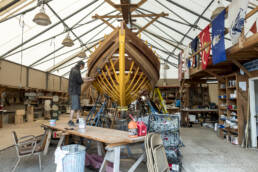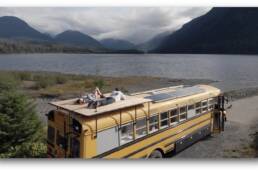The teachers at this esteemed Olympic Peninsula institution know that while owning a boat will change your life, building one may change who you are. Story by Colin Wiseman.
Boatbuilding changes lives—according to Betsy Davis, at least.
The executive director of the Northwest School of Wooden Boatbuilding (NSWB) since 2014, Davis speaks from personal experience. She worked at Microsoft at the startup stage, cashed in on the first wave of the dot-com bubble, then built a wooden boat. A dozen years later, Davis’s office is right on the salt in Port Hadlock, Washington, at the south end of Port Townsend Bay, on the east side of the Olympic Peninsula.
Above: a video about NWSB’s history and three alumni. Top: Student Griffin Richardson installs a plank on his vessel Blue Moon. Students own the boats they build. Photo by Colin Wiseman.
The six-acre campus of the NWSB has a historical air. Boatbuilding has been taking place here for well over a century. Master boatbuilder Robert Prothero, teacher Libby Palmer, and designer Henry Yeaton founded the non-profit school in nearby Port Townsend in 1981. They wanted to preserve a tradition that “could not be found in textbooks.” It became one of only four schools in America to offer a focused education in wooden boatbuilding. By 1991, the school received national accreditation. In 2004, it moved to the current campus.
Student Ginny Wilson gives me a tour of the campus, from the 930-square-metre waterfront facilities to the upper campus, which includes the 585-square-metre Hammond Shop, built in 2011. Out the back door are an additional 418 square metres of workspace, including a mill and a large canvas shelter that is largely used for restoration projects. These were added in 2015. Out in the bay, a handful of sailboats and smaller craft are moored. Construction is underway on a new seawall.
NSWB is one of only four schools in America to offer a focused education in wooden boatbuilding.
Wilson’s in her last quarter of the year-long Traditional Wooden Boatbuilding program, which culminates in an Associate of Occupational Studies degree. There’s also a 12-month Contemporary Wooden Boatbuilding option and a new six-month Marine Systems course, which can be pursued on its own or as an extension of the boatbuilding work. All are offered in a hands-on apprenticeship-style environment. The students get to build a boat. Wilson and a small cohort are headed to Tasmania this fall to participate in a wooden-boat festival. The school graduates roughly 40 to 60 students per year—over 1,500 since 1981—and half of them come from out of state.
As for the desired outcome? “Some people might get a job building boats,” Davis says. “But not everyone. Boats are the subject matter, but the skill set goes beyond boats. They know how to use tools, they know how to problem solve, they know how to execute a project beginning to end. The boat school draws people with a sense of intention—they come with curiosity and a readiness to learn, and many of them find a new passion, a new path in life.”
Related Stories
Is This The Coolest School Bus In The Pacific Northwest?
Louisa Gilbert of Wild Bus Films has turned a simple yellow school bus into an off-grid travelling palace. This is…
Delta’s Farm Roots Mini School Is Gaining Ground
Along the fertile banks of the Fraser River, kids are learning society's rite to grow. By Lisa Richardson. Some…
How One Man Survived Residential School To Become A Professional Skateboarder
The New Yorker has published a short documentary about Joe Buffalo, a Canadian Cree and professional skateboarder who…
A Wooden Skyscraper? Yep. A Kootenay Company is Making it Happen in Vancouver
A team of self-professed high-tech Kootenay hippies is helping build a tower of timber within Vancouver's glass and…
Saving The Salish Sea in the Pacific Northwest
Two National Geographic photographers and marine biologists are trying to get the Salish Sea, which includes the Strait…
Who’s The Best Band in the Pacific Northwest Heavy-Metal Scene?
Born from record bins, basements and Cascadia’s blue-collared past, the Pacific Northwest heavy-metal scene has torn a…








